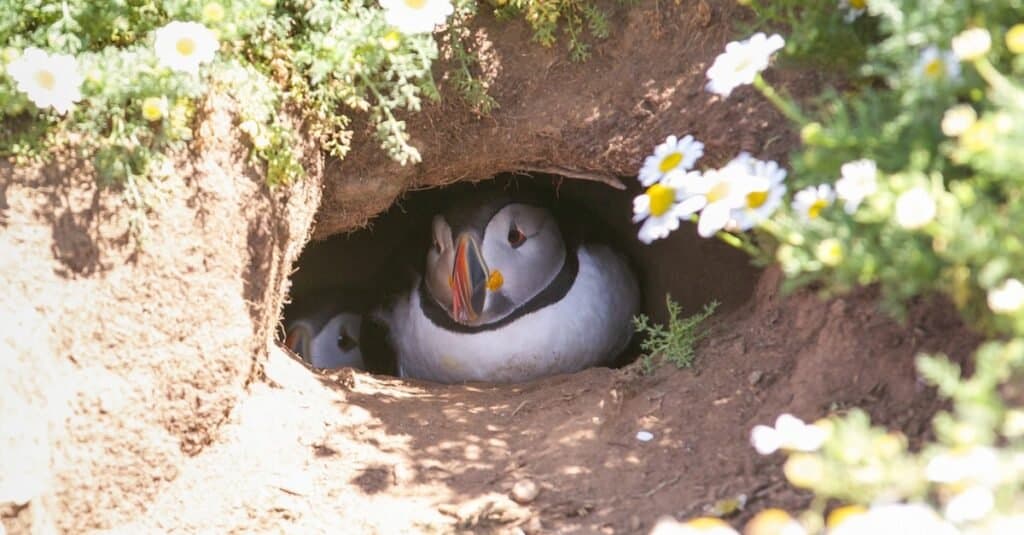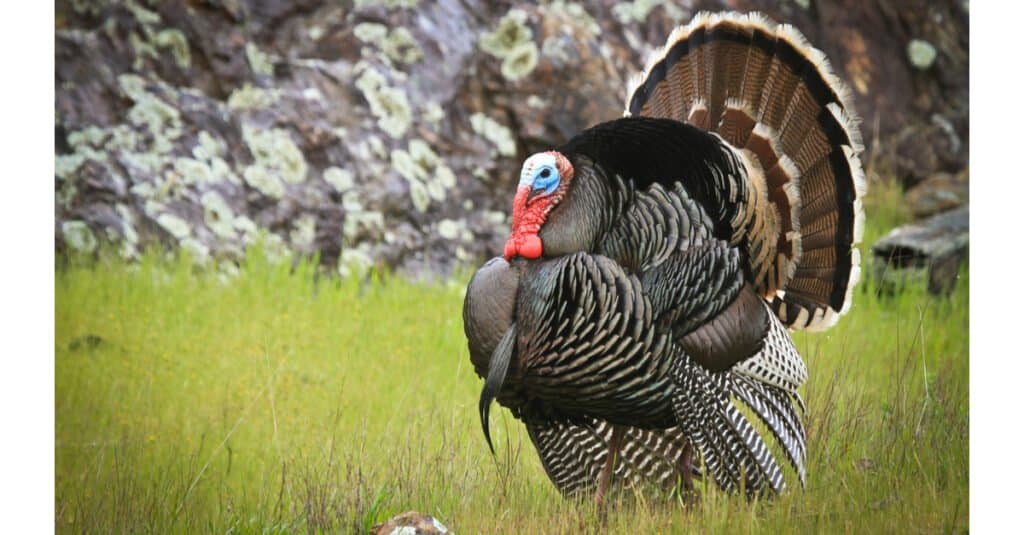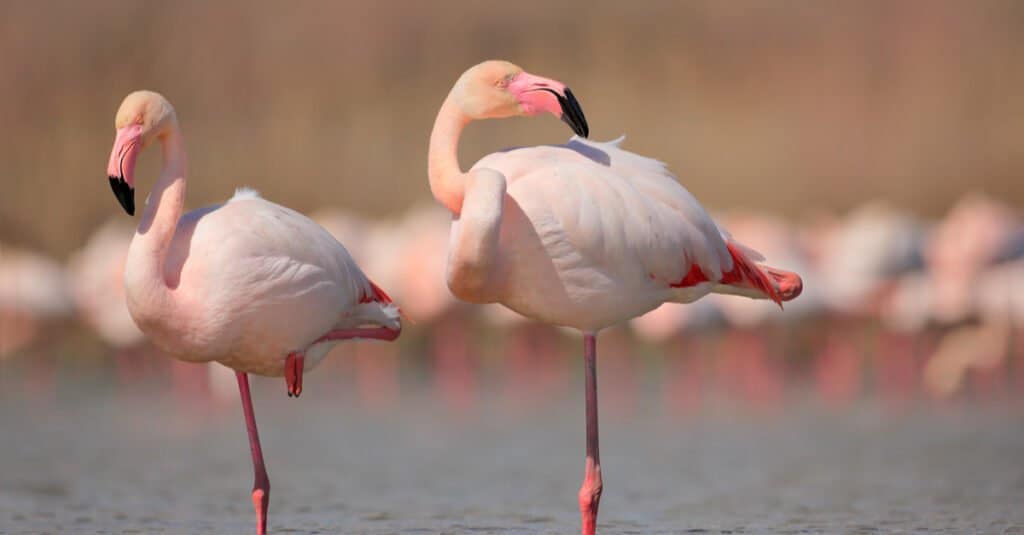What Kind Of Animal Builds A Nest Out Of Wood
When you recall of a bird's nest, where do you imagine the nest is located? Most people imagine a loving cup nest in a tree, which is understandable. At some point or other nosotros've all seen a bird'south nest in a tree, and our media enforces this image in TV and movies. The reason behind building a nest in a tree is well-founded. From tiny songbirds to huge eagles, lots of birds build their nests in trees to protect themselves from predators. However, some birds buck this trend. These birds may build flat platforms, scrape, or burrow nests on or in the ground to hold their eggs. There are many birds that nest on the ground, and it would be difficult to name them all. That said, information technology'south a much easier job to divide them into categories.
In this commodity, nosotros'll wait at 5 categories of birds that nest on the footing. Furthermore, nosotros'll provide specific examples of bird species in each category that exhibit this behavior. Hither are the five groups of birds that build their nests on the ground.
#5: Shorebirds

The term shorebirds refers to a group of birds that live near littoral wetlands and shorelines. While sometimes used synonymously with wading birds, shorebirds include not-wading birds that live well-nigh coasts and mudflats. Shorebirds include avocets, terns, gulls, sandpipers, stilts, plovers, puffins, and penguins. Commonly constitute almost rocky or sandy shorelines and shallow waters, most shorebirds migrate in the wintertime to more temperate climates. Some of the birds that migrate the longest come up from the shorebird category. These birds summertime in Arctic or sub-Arctic habitats, and summertime in tropical environments on the other side of the world. Most shorebirds that nest on the footing do then because trees abound sparsely in their natural habitats. As a result, they adapted to building nests on rocky or sandy patches of ground.
American avocets build their nests in large colonies that may constitute hundreds of birds. They construct their nests nigh water, particularly on islands with little vegetation. The American avocet scratches out a scrape nest and lines it with feathers, rocks, grass, and other small objects. To forestall their eggs from overheating, adults may wet their bodies while incubating to cool off their eggs. The Atlantic puffin is another bird that nests on the footing, or rather in the basis. They typically dig a burrow nest in the clay or brand a nest inside a scissure between rocks. The nest is then lined with grass and twigs to provide insulation and protection for the eggs. Unlike virtually birds, puffins may reuse the same nest year later on twelvemonth rather than making a new one.
#4: Game Birds

Tory Kallman/Shutterstock.com
Game birds include whatever number of birds traditionally hunting for food past humans. Species included in the game birds category include quail, partridge, pheasants, turkeys, bickering, and guineafowl. Nigh all game birds nest on the footing because nearly do non fly well enough to build nests in trees. Well-nigh game birds do non migrate and live twelvemonth-circular in their convenance habitats. While many game birds construct their nests inside shelters, others build theirs out in the open. Furthermore, due to their use in sport hunting, some game birds now live on managed estates. Groundskeepers ensure that enough game birds breed to ensure their population remains stable for continued hunting. There also exists a substantial commercial industry that raises game birds for mass consumption. That said, many game birds go on to live in the wild.
Wild turkeys mostly build their nests in woodland habitats. However, they tend to construct their nests virtually treelines abutting roads, fields, or other clearings. The nests are made in shallow depressions in the basis and lined with twigs and arboreal vegetation. They locate their nests in areas with enough of overhead embrace, such as a thicket or beneath depression-hanging branches. Guineafowl also build their nests on the ground. Their natural instinct is to choose a secluded location for their nest, including areas with tall grass or fallen branches. That said, as guineafowl live in flocks, multiple females may lay eggs in the same nest. A single nest may concord up to 50 eggs at a time and will continue to grow until one of the females decides to breed the clutch.
#iii: Waterfowl

Sergei25/Shutterstock.com
The term waterfowl refers to a number of species of aquatic birds, specifically swimming game birds. Species that fall under the waterfowl label include ducks, geese, and swans. About waterfowl live near wetlands and count among birds that nest on the ground. They tend to build their nests almost water, as their hatchlings are precocial. This means that before long after they hatch, waterfowl young can movement about and take intendance of themselves. Therefore, waterfowl have no biological incentive to build their nests up in trees or at high elevations to protect their immature from predators. Many species drift after the breeding flavor to warmer climates and volition return in spring once the weather changes.
Mute swans take a unique approach when they build their nests. Many cull to build their nests on islands in the eye of a lake or shut to its edge. Mute swans build big cup nests, with the largest measuring up to vi anxiety long and 1.5 to two feet high. The male swan volition construct the nest out of vegetation and feathers. Nevertheless, if it'south not up to the female's standards, she may brand him beginning over. Different the mute swan, the American wigeon chooses to locate its nest far away from h2o. It'south non uncommon to notice an American wigeon nest more than than 100 anxiety from the edge of the nearest body of water. To protect their eggs, they hibernate their nests in areas with tall weeds and grasses. The female will make a scrape nest, and and then line it with grasses, aquatic vegetation, and feathers.
#two: Wading Birds

Ondrej Prosicky/Shutterstock.com
Sometimes lumped together with shorebirds, wading birds include long-legged birds that primarily alive near wetland habitats. Wading birds include flamingos, spoonbills, storks, ibises, cranes, herons, and rails. Well-nigh wading birds that nest on the ground exercise then nearly marshes, lakes, or swamps. That said, a number of wading birds choose to build their nests above water, including wood storks and cracking blue herons. Similar shorebirds and waterfowl, most wading birds migrate during the winter to more than temperate climates. However, some will remain in their breeding range year-round.
Flamingos construct unique nests fabricated out of mud, stones, dry grasses, and feathers. Both the male and female will work together to build the nest. With their bills, they will drag mud and objects into a mound, then use their anxiety to shape the nest. The whole process can accept up to vi weeks. By the time they finish, the mound may stand most 12 inches off the footing. Meanwhile, sandhill cranes build flat platforms nests made out of twigs, grasses, branches, and weeds. The female is ultimately responsible for building the nest, although the male volition help assemble materials. Sandhill crane nests can measure four to five anxiety long by the time the female finishes amalgam the platform. Yet, the female person will likely go on to add materials while incubating her eggs.
#i: Songbirds

Songbirds include any 1 of over 5000 dissimilar species of perching birds. While most songbirds nest in copse, there are some birds that nest on the ground. These include hermit thrushes, bobolinks, larks, meadowlarks, and some species of sparrow and warbler. Usually, songbirds build their nests in trees to protect them from predators. Songbird hatchlings must remain in the nest for several days or weeks before they tin leave and intendance for themselves. This disability to intendance for themselves is why most songbirds build their nests at high elevations away from predators. However, the songbirds that build their nests on the ground found a different way to keep their young safety.
The western meadowlark nests on the footing in open prairies and grasslands beyond the western U.s.a., United mexican states, and Canada. Female meadowlarks volition choose a nesting site based on how well it is hidden. Normally, they will choose a spot where in that location is a dip in the ground and surrounded by vegetation. While most western meadowlarks construct simple scrape or cup nests, others go to nifty lengths to protect their immature. These enterprising mothers will weave together the surrounded grasses to make a cover for their nest. Bobolinks are another songbird that nests on the ground. Like western meadowlarks, the female person will choose the nesting site and construct the nest herself. The nest is usually constructed on moisture soil, and made from woven stems and grasses into a loving cup shape Once the shape is gear up, the female bobolink will line information technology with soft sedges and grasses.
Source: https://a-z-animals.com/blog/5-birds-that-nest-on-the-ground/
Posted by: duncanfachaps00.blogspot.com

0 Response to "What Kind Of Animal Builds A Nest Out Of Wood"
Post a Comment